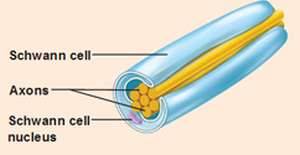

MedFriendly®


Unmyelinated
Unmyelinated is a descriptive term for a nerve fiber that
is not covered by myelin. Myelin is a fatty substance
that helps nerves transmit messages fast. Nerve fibers
that are covered by myelin appear white because
myelin is made up mostly of fat.
By contrast, nerve fibers that lack myelin appear gray,
which is where the term gray matter comes from to
describe gray appearing tissue in the brain.
Axons encircled by a Schwann
cell (support cell) but not wrapped
by myelin.
FEATURED BOOK: Principles of Neural Science by Kandel
Impulses that travel along unmyelinated nerves fibers move as continuous waves
whereas impulses that travel along myelinated nerve fibers move by skipping from one
gap between the myelin to another. These gaps are known as nodes of Ranvier.
Due to the presence of myelin, information travels much faster alone myelinated nerve
fibers than unyelinated nerve fibers. However, in most cases, unmyelinated nerve fibers
are short, which means that the signal speed is not that important for the type of
information that needs to be transmitted. Whereas myelinated nerve fibers can regrow,
unmyelinated nerve fibers do not regrow if damaged. An example of unmyelinated nerve
fibers are C fibers. Unmyeliated is also known as nonmyelinated, amyelinated,
nonmedullated, unmedullated, and amyelinic. Unmyelinated comes from the Anglo Saxon
word "un" meaning "not," and the Greek word "myelos" meaning "marrow." Put the words
together and you have "not marrow."
"Where Medical Information is Easy to Understand"™















